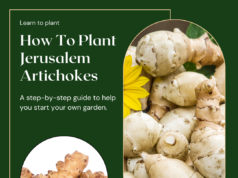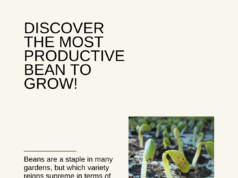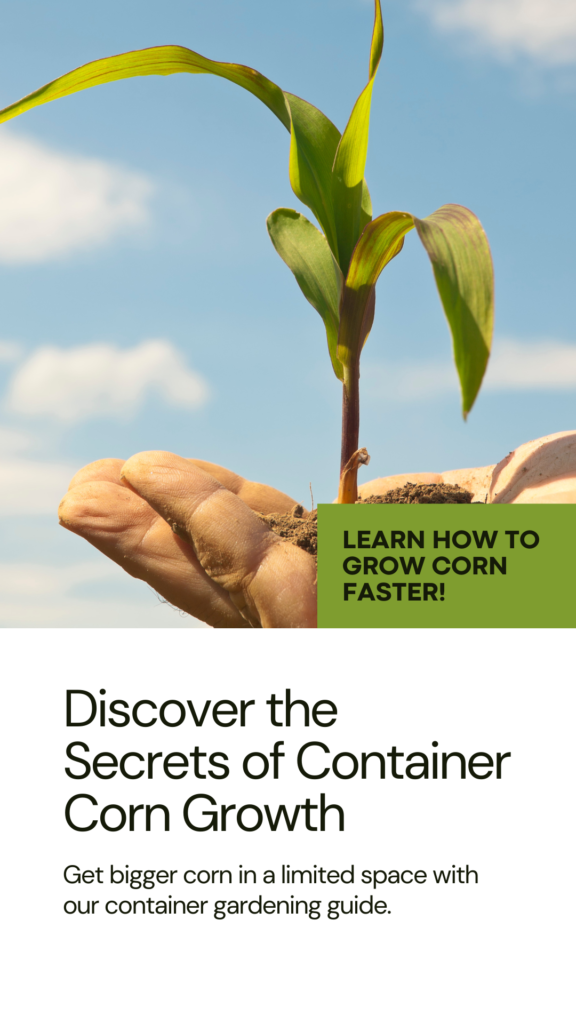
Welcome to our expert guide on growing corn in containers. Whether you have limited space in your backyard or an urban garden, container gardening is a fantastic solution for cultivating corn and enjoying a bountiful harvest. In this article, we will share valuable tips and techniques to help you grow corn faster, even in small spaces.
Key Takeaways:
- Container gardening is a great way to grow corn in small spaces or urban gardens.
- Choosing the right container and providing proper drainage are essential for successful corn growth in containers.
- Selecting the right corn variety and creating ideal growing conditions are key factors in maximizing your corn crop.
- Proper watering, fertilizing, and managing pests and diseases are crucial for healthy corn plants in containers.
- Harvesting at the right time and maintaining your corn plants will ensure the best flavor and texture.
Choosing the Right Container for Growing Corn
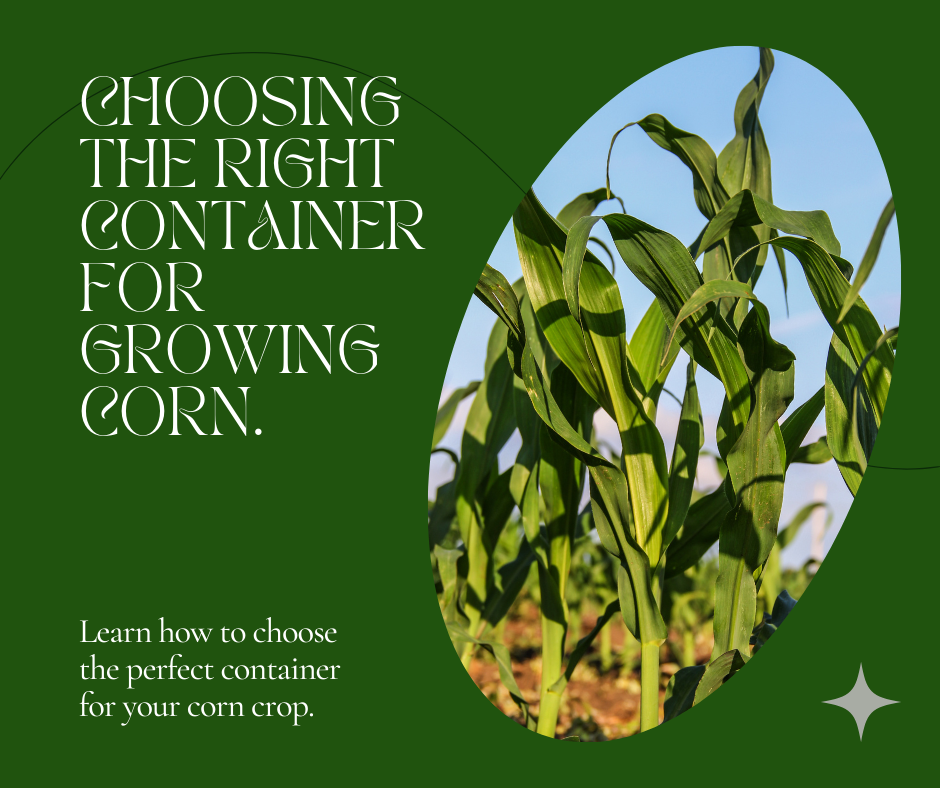
Selecting the appropriate container is crucial for successfully growing corn in limited spaces, such as containers or urban gardens. The container you choose will directly impact the growth and development of your corn plants. Here are some factors to consider when choosing the right container for growing corn:
Container Size
When it comes to container size, bigger is generally better for corn plants. Corn has an extensive root system, and providing enough space for the roots to spread will ensure healthy growth and optimal yields. It is recommended to choose a container with a minimum depth of 12 inches and a capacity of at least 5 gallons to accommodate the corn’s root structure.
However, if you have limited space, you can still grow corn in smaller containers by selecting dwarf or compact corn varieties that require less space. These varieties are specifically bred to grow well in containers and can reach heights of about 4-5 feet.
Container Options
There is a wide range of container options available for growing corn, including plastic pots, wooden boxes, fabric grow bags, and even repurposed items such as buckets or barrels. Each container type has its own advantages and considerations.
Expert Tip: When using containers made of materials that absorb heat, such as metal or dark-colored plastic, consider placing them in partial shade to prevent the soil from overheating, which can stress the corn plants.
Plastic pots are lightweight, durable, and come in various sizes. They provide good insulation, retaining moisture and regulating soil temperature. Wooden boxes are a popular choice for their aesthetic appeal and excellent drainage. Fabric grow bags are breathable and promote better air circulation around the roots. Repurposed containers can be cost-effective and environmentally friendly options.
Drainage
Ensuring proper drainage is vital for the success of container-grown corn. Corn plants require well-draining soil to prevent waterlogging, which can lead to root rot and other issues. To improve drainage, consider adding a layer of gravel or broken pottery pieces at the bottom of the container.
| Container Type | Pros | Cons |
|---|---|---|
| Plastic Pots | Lightweight, durable, various sizes | May retain excess moisture if not properly drained |
| Wooden Boxes | Aesthetic appeal, good drainage | May require regular maintenance to prevent rot |
| Fabric Grow Bags | Better air circulation, lightweight | May dry out more quickly, requires frequent watering |
| Repurposed Containers | Cost-effective, environmentally friendly | May not have ideal drainage or insulation properties |
Consider these container options and their respective pros and cons to make an informed decision based on your specific needs and constraints. Remember to prioritize container size, material, and drainage to provide the best growing environment for your corn plants.
Ensuring Proper Drainage for Corn Growth
Proper drainage is crucial for the health and growth of corn plants in containers. Without adequate drainage, excess water can accumulate, leading to waterlogging and root rot. To ensure the optimal growth of your container-grown corn, it’s essential to create an effective drainage system that allows excess water to escape.
Here are some techniques you can use to ensure proper drainage for your corn plants in containers:
- Elevate the container: Place your corn container on bricks or blocks to elevate it slightly. This helps promote airflow and prevents water from pooling around the roots.
- Add drainage holes: Drill or puncture drainage holes in the bottom of the container. These holes should be large enough to allow water to escape but small enough to prevent soil from draining out.
- Use a layer of gravel: Place a layer of coarse gravel or small stones at the bottom of the container before adding soil. This layer helps facilitate drainage by creating space for water to flow out of the container.
- Choose well-draining soil: Opt for a high-quality potting mix specifically formulated for container gardening. These mixes often contain ingredients such as perlite or vermiculite, which improve drainage.
By implementing these techniques, you can prevent waterlogged soil and ensure that your container-grown corn plants receive the proper drainage they need for healthy growth and development.
Quote:
“Proper drainage is the key to successful corn growth in containers. By allowing excess water to escape, you can avoid waterlogging issues and promote healthy corn plants.” – Gardening Expert
Image: Ensuring Proper Drainage
| Benefits of Proper Drainage: | Consequences of Poor Drainage: |
|---|---|
| Prevents waterloggingReduces the risk of root rotImproves nutrient absorptionEnhances oxygen availability | Waterlogged soilRoot suffocationStunted growthDisease susceptibility |
Selecting the Right Corn Variety for Container Gardening
When it comes to container gardening, not all corn varieties are created equal. To ensure a successful harvest of corn in containers, it’s crucial to select the right corn variety that is well-suited for container gardening. Consider various factors such as height, space requirements, and maturity time to make an informed decision for your container garden.
One key consideration when choosing a corn variety for container gardening is height. Some corn varieties can grow quite tall, reaching heights of 8 to 10 feet or more. While this may be suitable for traditional garden beds, it can pose challenges in containers, especially if you have limited vertical space. Opting for compact or dwarf corn varieties can help you overcome this obstacle and still enjoy a bountiful harvest.
Space requirements are another essential factor to consider. Corn plants require adequate space for their roots to develop and spread. In a container, space is limited, so selecting a corn variety that is known for its compact root system is crucial. Look for varieties that are specifically bred for container gardening as they are more likely to have smaller root systems that can thrive in restricted areas.
Maturity time is also an important factor to consider. The time it takes for corn to reach maturity varies depending on the variety. If you have a short growing season, it’s recommended to choose corn varieties that have a shorter maturity time. These early-maturing varieties can mature in as little as 60 to 70 days, allowing you to enjoy fresh corn before the season ends.
To help you make an informed decision, here’s a table comparing different corn varieties suitable for container gardening:
| Corn Variety | Height | Space Requirements | Maturity Time |
|---|---|---|---|
| Golden Bantam | 5-6 feet | Compact | 70-80 days |
| Sequoia | 6-7 feet | Compact | 80-90 days |
| On Deck | 4-5 feet | Compact | 70-80 days |
| Bodacious | 6-7 feet | Compact | 75-85 days |
Note: The height mentioned is an approximation, as it may vary depending on growing conditions.
By considering these factors and choosing the right corn variety, you can set your container garden up for success. Remember to also check the seed packet or consult with local gardening experts to ensure you choose a variety that thrives in your specific climate and growing conditions.
Providing the Ideal Growing Conditions for Corn in Containers
Creating the ideal growing conditions is essential for the successful growth of corn in containers. Corn plants have specific requirements for optimal growth, including sunlight, temperature, and soil conditions. By understanding these needs and providing the right environment, you can ensure that your container-grown corn plants thrive and produce a bountiful harvest.
Sunlight: Corn is a sun-loving plant that requires full sun to grow and develop properly. Place your containers in an area that receives at least 6-8 hours of direct sunlight per day. If you have limited sunlight in your space, consider using reflective surfaces or mirrors to redirect sunlight onto the corn plants.
Temperature: Corn plants prefer warm temperatures for optimal growth. The ideal temperature range for corn in containers is between 60-86°F (15-30°C). Ensure that your containers are placed in a location with consistent temperatures within this range. Protect your corn plants from extreme heat or cold by providing shade during scorching summer days or moving them indoors during frosty nights.
Soil Conditions: Choosing the right soil and maintaining proper soil conditions are crucial for corn in containers. Use a high-quality potting mix or a well-draining soil combination. The soil should be loamy, rich in organic matter, and have good moisture retention while avoiding waterlogging. Consider adding compost or organic fertilizer to enrich the soil and provide essential nutrients to the corn plants.
| Key Growing Conditions for Corn in Containers | Optimal Range |
|---|---|
| Sunlight | 6-8 hours of direct sunlight per day |
| Temperature | 60-86°F (15-30°C) |
| Soil Conditions | Well-draining, loamy soil with good moisture retention |
By providing the ideal growing conditions of ample sunlight, suitable temperatures, and well-draining soil, you can create an optimal environment for your container-grown corn plants to thrive. Remember to regularly monitor and adjust these conditions as needed to ensure the best growth and yield from your corn crop.
Watering and Fertilizing Corn in Containers
Proper watering and fertilizing are crucial for the growth and yield of corn plants in containers. By following the right techniques and schedule, you can ensure that your container-grown corn receives the essential nutrients it needs to thrive.
Watering Schedule
When it comes to watering corn in containers, consistency is key. It’s important to maintain a regular watering schedule to prevent the soil from drying out or becoming waterlogged.
- Water your corn plants deeply and evenly, ensuring that the water reaches the root system.
- Check the moisture level of the soil regularly by inserting your finger about an inch deep. If it feels dry, it’s time to water.
- During hot weather, corn plants may require more frequent watering to prevent dehydration.
- Avoid overhead watering as it can lead to fungal diseases. Instead, use a watering can or a drip irrigation system to water the base of the plants.
Fertilizing Techniques
In addition to watering, providing your container-grown corn with the right fertilizers is essential for its growth and nutritional needs.
- Use a balanced slow-release fertilizer that is specifically formulated for vegetables. Follow the package instructions for application rates.
- Apply fertilizer when planting the corn and then again after two to three weeks.
- Topdress the soil with compost or well-rotted manure to improve nutrient levels and soil structure.
- Consider using organic fertilizers to promote healthy and sustainable growth.
Remember, over-fertilization can be detrimental to your corn plants. Always follow the recommended dosage and avoid using excessive amounts of fertilizer.
Tips for Successful Watering and Fertilizing
To ensure optimal watering and fertilizing for your container-grown corn, keep these tips in mind:
- Pay attention to the weather conditions and adjust your watering schedule accordingly. Corn plants may require more water during periods of intense heat.
- Monitor your corn plants for signs of nutrient deficiency, such as yellowing leaves or stunted growth. Adjust your fertilizing regimen if necessary.
- Consider using a water-soluble fertilizer once a month to provide quick nutrient uptake.
- Avoid fertilizing your corn plants during dry spells, as the lack of water can lead to fertilizer burn.
Following these watering and fertilizing techniques will help promote healthy growth and maximize the yield of your corn plants in containers. Remember to regularly monitor the moisture level of the soil and adjust your watering schedule accordingly. With proper care and attention, you can enjoy a bountiful harvest of corn from your container garden.
Managing Pests and Diseases in Corn Container Gardening
Corn plants in containers can be susceptible to various pests and diseases. It is important to be proactive in managing these issues to protect your crop and ensure the health and growth of your corn plants. By understanding common pests and diseases and implementing organic solutions, you can effectively manage and maintain the vitality of your corn plants.
Common Pests Affecting Corn Plants
When growing corn in containers, you may encounter pests such as:
- Corn earworms
- Armyworms
- Corn borers
- Southern corn leaf beetles
- Aphids
These pests can cause damage to your corn plants by feeding on leaves, stems, or cobs, leading to reduced yield and weakened growth. It is essential to identify and address these pest infestations promptly.
Preventative Measures
To protect your corn plants from pests, consider implementing the following preventive measures:
- Regularly inspect your corn plants for signs of pest activity, including chewed leaves, holes in cobs, or visible insects.
- Remove and destroy any infected or infested plant parts to prevent the spread of pests.
- Encourage natural predators of pests, such as ladybugs or lacewings, by planting companion plants that attract beneficial insects.
- Consider using physical pest barriers, such as row covers or sticky traps, to prevent pests from reaching your corn plants.
By taking these preventative measures, you can significantly reduce the risk of pest infestations and minimize the damage caused to your corn crop.
Organic Solutions for Corn Diseases
In addition to pests, corn plants in containers can also be susceptible to diseases, such as:
- Common rust
- Gray leaf spot
- Stalk rot
- Leaf blight
To combat these diseases, organic solutions can be effective:
- Plant disease-resistant corn varieties suitable for container gardening.
- Practice crop rotation by avoiding growing corn or related crops in the same container or area consecutively.
- Ensure proper spacing between corn plants to promote air circulation and reduce the risk of disease spread.
- Apply organic fungicides or biological control agents to manage and suppress disease development.
By implementing these organic solutions, you can protect your corn plants from disease and foster a healthy growing environment.
| Pest/Disease | Description | Preventive Measures | Treatment |
|---|---|---|---|
| Corn earworms | A pest that feeds on corn kernels | Plant trap crops, apply natural insecticides | Handpick or use organic pesticides |
| Common rust | Fungal disease causing orange or brown lesions on leaves | Choose resistant corn varieties, water at the base | Apply organic fungicides, remove affected leaves |
| Gray leaf spot | Fungal disease causing gray lesions on leaves | Plant disease-resistant corn varieties, practice crop rotation | Apply organic fungicides, remove affected leaves |
| Stalk rot | Fungal disease causing weakened stalks and rotting | Ensure proper spacing, avoid excessive nitrogen application | Prune infected stalks, apply organic fungicides |
By identifying pests and diseases early on and implementing these preventative measures and organic solutions, you can effectively manage and maintain the health of your corn plants in containers. This ensures a successful corn harvest and allows you to enjoy the rewards of your container gardening efforts.
Harvesting and Maintaining Corn in Containers
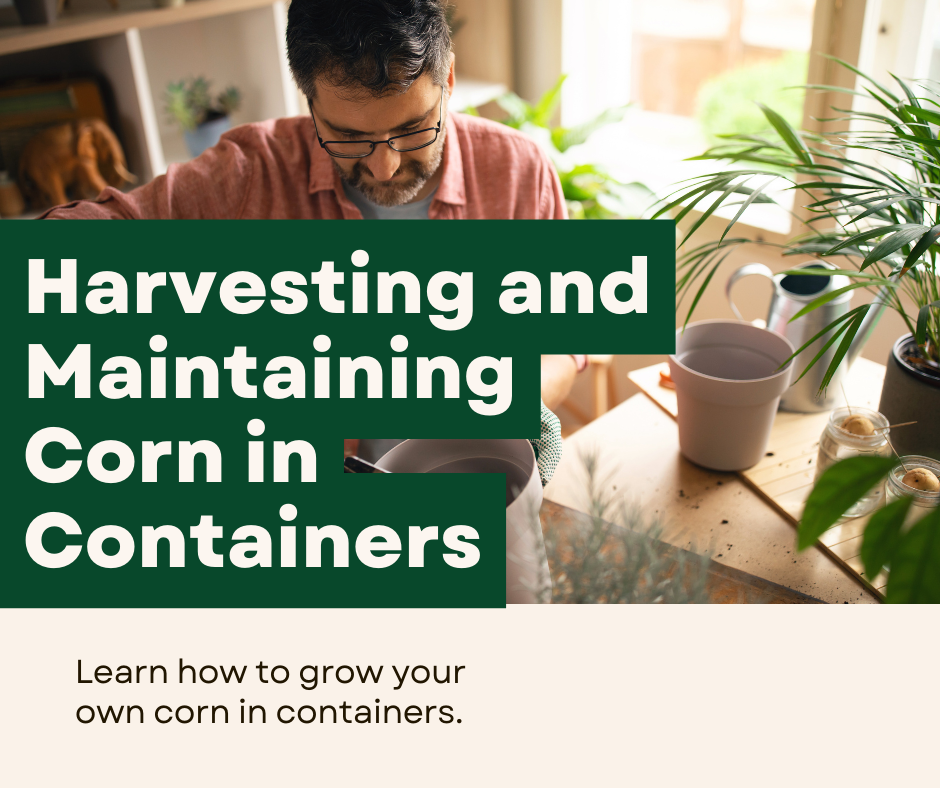
Once your container-grown corn is thriving and nearing maturity, it’s essential to know when and how to harvest your crop to enjoy the best flavor and texture. Harvesting corn at the right time ensures optimal taste and tenderness. Here are some pointers to guide you through the process.
Indicators of Ripeness
There are a few signs that indicate when your corn is ready for harvest:
- Feel the kernels: Gently press your thumb against a kernel. If it emits a milky, creamy substance, your corn is ripe and ready for picking.
- Tassels and silk: Once the tassels on top of the corn cob have turned brown and dried, and the silk has withered and turned brownish, it’s a good indication that the corn is mature.
- Corn husks: The husks surrounding the cob should be green and tightly wrapped. If the husks have started to loosen or turn brown, it may be a sign of over-maturity.
Harvesting Techniques
When it’s time to harvest, use the following techniques:
- Grasp the corn ear: Hold the corn ear firmly with one hand.
- Twist and pull: With the other hand, twist the corn ear downward and pull it away from the stalk with a swift motion.
- Inspect the ear: While still in the garden, inspect the ear to ensure it looks plump, filled to the tip, and the kernels are mature.
It’s essential to harvest your corn promptly once it reaches maturity to prevent over-ripening or a decrease in flavor and tenderness.
Pruning and Maintaining Corn Plants
In addition to proper harvesting, it’s important to prune and maintain your corn plants for optimal growth and maximum yield. Pruning helps remove excess foliage, improving air circulation and reducing the risk of disease. Follow these tips for pruning and maintenance:
- Remove suckers: Suckers are small shoots that emerge from the base of the corn plants. By removing these suckers, you direct the plant’s energy towards the main stalk, promoting healthier growth.
- Trim damaged leaves: Remove any damaged or yellowing leaves to prevent the spread of diseases and allow the plant to focus its energy on healthier foliage and cob development.
- Provide support: As your corn plants grow taller, make sure to provide adequate support to prevent them from falling over. Use stakes or plant cages to secure the plants and prevent damage.
By regularly pruning and maintaining your corn plants, you not only improve their overall health but also enhance the quality and yield of your harvest.
Now that you know when and how to harvest container-grown corn and the importance of pruning and maintaining your plants, you’re well-equipped to enjoy a successful corn harvest in your own container garden.
| Harvesting and Maintaining Corn in Containers: Quick Tips | |
|---|---|
| Harvesting | Maintenance |
| Harvest corn when kernels emit a milky substance. | Remove suckers and damaged leaves regularly. |
| Check tassels and silk for maturity indicators. | Provide support to prevent plants from falling over. |
| Ensure green and tightly wrapped husks. | |
FAQ
Q. How can I select the right container for growing corn?
A. When choosing a container for corn in containers, opt for a large container with a minimum size of 20 inches in diameter and depth. Ensure the container has drainage holes to prevent waterlogging and promote healthy root growth.
Q. How can I ensure proper drainage for corn growth in containers?
A. To ensure proper drainage for corn in containers, place a layer of gravel or small stones at the bottom of the container before adding soil. This will allow excess water to flow out of the container and prevent waterlogging, which can lead to root rot.
Q. What are the suitable corn varieties for container gardening?
A. For container gardening, choose compact corn varieties such as ‘Golden Midget’ or ‘Tom Thumb’. These varieties are specifically bred to thrive in small spaces and have shorter maturity times, making them ideal for container gardening.
Q. What are the ideal growing conditions for corn in containers?
A. Corn plants in containers require full sun for at least 6 to 8 hours a day. They also prefer well-draining soil with a pH level between 5.8 and 6.8. Maintain a consistent soil temperature between 60°F and 95°F for optimal corn growth.
Q. How should I water and fertilize corn in containers?
A. Water corn in containers deeply, ensuring the soil is evenly moist, but not waterlogged. Fertilize regularly with a balanced fertilizer, following the manufacturer’s instructions. Supplement with organic matter or compost to provide essential nutrients for healthy growth.
Q. How can I manage pests and diseases in corn container gardening?
A. Common pests that affect corn plants in containers include aphids, corn earworms, and armyworms. Use organic solutions such as neem oil or insecticidal soap to control pests. Prevent diseases by ensuring proper watering, adequate air circulation, and practicing good hygiene in your container garden.
Q. When is the right time to harvest container-grown corn?
A. Corn is ready to be harvested when the ears are plump and the silks have turned brown. Gently peel back the husk and pierce a kernel with your fingernail. If a milky liquid squirts out, the corn is ready for harvest.
Q. How should I prune and maintain corn plants in containers?
A. Prune corn plants by removing any suckers or side shoots that emerge from the base of the plant. This will redirect energy to the main stalk and promote better growth. Maintain the health of your corn plants by regularly checking for pests and diseases and providing the necessary care and nutrition.
Conclusion
Congratulations on taking the first step towards successful corn growth in containers! By implementing the tips and recommendations shared in this article, you can turn your limited space or urban garden into a thriving corn-filled haven. Remember, the key to a bountiful harvest lies in choosing the right container, ensuring proper drainage, selecting the suitable corn variety, providing the ideal growing conditions, and practicing proper maintenance.
When selecting a container for growing corn, consider the size and ensure there is enough space for the plants to grow and develop healthy root systems. Proper drainage is crucial to prevent waterlogging and root rot, so make sure to create an optimal drainage system that allows excess water to escape.
Choosing the right corn variety is essential for container gardening success. Look for varieties that are suitable for smaller spaces and have shorter maturity times. Provide your corn plants with the ideal growing conditions by ensuring they receive adequate sunlight, maintaining optimal temperature, and using well-draining soil. Regular watering and fertilizing will help your corn plants thrive, so be sure to follow the recommended schedule and use suitable fertilizers.
Lastly, stay vigilant in managing pests and diseases that may affect your corn plants. Regularly inspect your plants for any signs of trouble and take prompt action using organic solutions to keep your corn crop healthy. With proper care and maintenance, you’ll soon be enjoying the rewards of growing fresh and delicious corn right at home!




